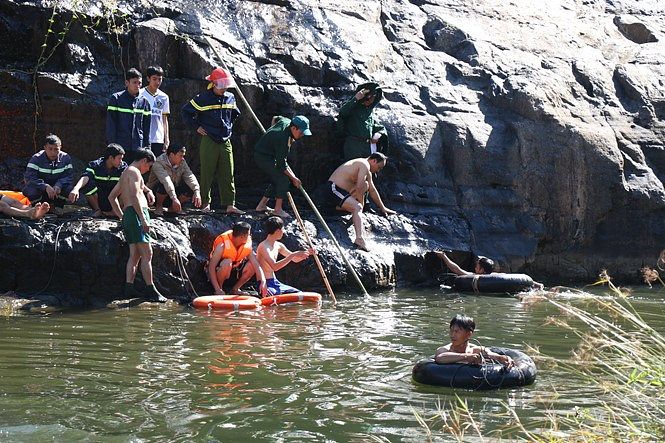The dense, untouched forests of Phong Nha-Ke Bang National Park in Quang Binh province hide some of the world’s greatest underground geological formations. Beneath the park’s stunning limestone mountains lie Son Doong, the largest cave on the planet, and Hang En, the third-largest behind Deer Cave in Malaysian Borneo.
Hang En is accessible to visitors thanks to Oxalis Adventure Tours, an outdoor tourism specialist located in the growing town of Phong Nha, the center of tourism in the park. A 25-kilometer, two-day, one-night trek takes you through gorgeous forests, deep valleys, across rivers and into mighty Hang En, where you camp for the night.
I’ve visited nearly every province in Vietnam, and while the country is undeniably beautiful, oftentimes economic and tourism development lays waste to the environment. On Phu Quoc, for example, resorts are paving over the very beaches that originally attracted people to the island. Ha Long Bay, long the nation’s star natural attraction, is full of garbage and cruise ships.
Therefore I wasn’t quite sure what to expect from Phong Nha-Ke Bang, one of Vietnam’s largest national parks. As soon as we started hiking into the forest from our drop-off point along the deserted Ho Chi Minh Highway West, however, it was clear that this would be different.

With the exception of a tiny minority village called Doong, which sits completely off the grid amid jagged limestone mountains, there were no signs of humanity in the park. My 3G signal disappeared shortly after we left Phong Nha, and we were completely surrounded by green for the duration of the expedition. Monkeys called in the distance, while birds and butterflies twisted and twirled above the trail. Coming from the concrete jungle of Saigon, it was glorious.
After hiking down into a valley from the highway, we followed the course of the placid Rao Thuong River, though signs of nature’s power were everywhere. Huge logs and entire trees were strewn across parts of the path, ripped from the ground and delivered downstream by the historic floods which hit the area last fall.
We crossed the river countless times as we hiked toward Hang En, the clear, cool water bringing welcome relief from the sunny skies above. Late afternoon light poured into the valley, and eventually one of Hang En’s entrances loomed in the distance: a gaping arch stitched into the side of a mountain.

That entrance is inaccessible though, covered by a rockslide and formidable trees. We followed the river into a much smaller, ground-level opening, where we donned helmets and headlamps before heading inside. A cool breeze emanated from the cave, hinting at the hidden open space we were about to enter.
Our guides led us single-file through a rocky path onto an overlook with an awe-inspiring view: our tents set up on a sandy beach next to a lake inside an absolutely enormous chamber, illuminated by light streaming in through the massive arch we had seen outside. The campsite looked like a toy model in the vastness of Hang En.
The chirps of birds filled the space thanks to the cave’s namesake residents: a massive population of swallows. The tiny birds nest in the ceiling and aren’t shy about pooping on anything below them.


After dropping our bags off at the campsite we were led into another, much darker chamber, scrambling over rocks and across the river as it worked its way through the enormous cave. After walking up a small ridge, we were presented with a jaw-dropping view: a 120-by-100-meter opening at the other end of Hang En. The river flowed out into the park, while vines and plants covered the walls up to an incredible height.
With dusk approaching we walked back to camp, while tens of thousands of swallows returned to the cave for the night. The birds singing and the river burbling through the darkness created a new type of white noise for falling asleep in my tent.

The next morning, we explored Hang En’s third massive chamber, home to striking stalactites and stalagmites formed over millions of years. Fossils could be found on the darkened walls, a testament to the region’s former location at the bottom of the ocean.
Our headlamps lit the way as we climbed up a pile of rocks to reach one final viewpoint, which overlooked the campsite from behind. When we first entered Hang En it was difficult to fathom the enormity of the cave, but by the time we left it was clear just how gigantic the cavern is.
It was time to return to the sunlight, and another beautiful, hot day awaited as we sloshed through the river back into the valley. The rest of the hike was filled with unbroken natural scenery as we followed a different trail from the previous day, bypassing Doong village and avoiding any sign of human life.


The last stretch of the trek was the most physically challenging as we hiked straight up the side of a mountain out of the valley and back to the Ho Chi Minh Highway. A cooler of ice-cold beer and water awaited at the top, along with one final panorama of Phong Nha-Ke Bang’s epic wilderness. Hang En and the park are Vietnam at its wildest, and I’d argue there is no better place in the country to escape from civilization and reconnect with nature.
















